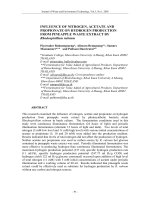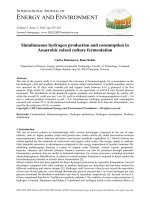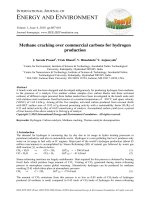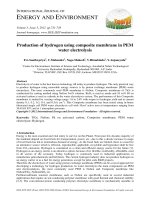HYDROGEN PRODUCTION HYDROGEN PRODUCTION
Bạn đang xem bản rút gọn của tài liệu. Xem và tải ngay bản đầy đủ của tài liệu tại đây (896.86 KB, 44 trang )
HYDROGEN PRODUCTION
Introduction
• Hydrogen production has become a priority in current refinery operations
and when planning to produce lower sulphur gasoline and diesel fuels.
Along with increased H2 consumption for deeper hydrotreating, additional
H2 is needed for processing heavier and higher sulphur crude slates. In
many refineries, hydroprocessing capacity and the associated H2 network
is limiting refinery throughput and operating margins. Furthermore,
higher H2 purities within the refinery network are becoming more
important to boost hydrotreater capacity, achieve product value
improvements and lengthen catalyst life cycles. Improved H2 utilisation
and expanded or new sources for refinery H2 and H2 purity optimisation
are now required to meet the needs of the future transportation fuel
market and the drive towards higher refinery profitability.
Hydrogen Consumption Data for a typical refinery producing 82SCFD
Of Hydrogen from Natural gas at a purity of 99.9 vol%
Hydrogen is usually manufactured by steam reforming
process. In some cases partial oxidation has also been
used, particularly where heavy oil is available at low cost.
However, oxygen is then required and the capital cost of
producing oxygen plant makes partial oxidation high in
capital cost.
Steam Reforming (conventional)
•
•
Steam reforming for hydrogen production is accomplished in four steps :
Reforming : This involves the catalytic reaction of methane with steam at
temperatures in the range of 1400 to 1500 0F (760-8160 C), according to the
following equation :
CH4 + H2O = CO + 3H2
This reaction is endothermic and is carried out by passing the gas through catalystfilled tubes in a furnace up to ¾ inch in diameter. It consists of 25 to 40% nickel
oxide deposited on a low silica refractory base.
•
Shift Conversion: More steam is added to convert the CO from step 1 to an
equivalent amount of hydrogen by the following reaction :
CO + H2O = CO2 + H2
This is an exothermic reaction and is conducted in a fixed-bed catalytic reactor at
about 6500F (3430C). multiple catalyst beds in one reactor are commonly
employed to prevent the temperature from getting too high, as this would
adversely affect the equilibrium conversion. The catalyst used is a mixture of
chromium and iron oxide.
• Gas Purification : The third step is removal of carbon dioxide by
absorption in a circulating amine or hot potassium carbonate solution.
Several other treating solutions are in use. The treating solution contacts
the hydrogen and carbon dioxide in an absorber containing about 24 trays,
or the equivalent amount of packing. Carbon dioxide is absorbed in the
solution, which is then sent to a still for regeneration.
• Methanation : In this step, the remaining small quantities of carbon
monoxide and carbon dioxide are converted to methane by the following
reactions :
CO + 3H2 = CH4 + H2O
CO2 + 4H2 = CH4 + 2H2O
This step is also conducted in a fixed-bed catalytic reactor at
temperatures of about 700 to 8000F (4270C). both reactions are
exothermic and, if the feed concentration of CO and CO2 is more than 3%,
it is necessary to recycle some of the cooled exit gas to dissipate the heat
of reaction. The catalyst contains 10 to 20% on a refractory base.
• Hydrogen produced from the SMR process includes small
quantities of carbon monoxide, carbon dioxide, and hydrogen
sulfide as impurities and, depending on use, may require
further purification. The primary steps for purification include:
• Feedstock purification – This process removes poisons,
including sulfur (S) and chloride (Cl), to increase the life of
the downstream steam reforming and other catalysts.
• Product purification – In a liquid absorption system, CO2 is
removed. The product gas undergoes a methanation step to
remove residual traces of carbon oxides. Newer SMR plants
utilize a pressure swing absorption (PSA) unit instead,
producing 99.99% pure product hydrogen.
Advantages
• Steam reforming of natural gas offers an efficient, economical, and widely
used process for hydrogen production, and provides near- and mid-term
energy security and environmental benefits. The efficiency of the steam
reforming process is about 65% to 75%, among the highest of current
commercially available production methods. Natural gas is a convenient,
easy to handle, hydrogen feedstock with a high hydrogen-to-carbon ratio.
It is also widely available from sources in the U.S. and Canada.
• The cost of hydrogen produced by SMR is acutely dependant on natural
gas prices and is currently the least expensive among all bulk hydrogen
production technologies. A well-developed natural gas infrastructure
already exists in the U.S., a key factor that makes hydrogen production
from natural gas attractive.
Drawbacks
• During the production of hydrogen, CO2 is also produced. The
SMR process in centralized plants emits more than twice the
CO2 than hydrogen produced.To avoid emission of CO2 into
the atmosphere, CO2 can be concentrated, captured, and
sequestered; sequestration concepts and technologies are
relatively new and there is no long-term test evidence to
prove that these technologies will be successful.
Sequestration in oceans is controversial because of the
possible adverse impact on the aquatic environment by the
reduction of ocean water pH.
Steam Reforming/PSA
•
Plants built since the mid-1980s are generally based on steam reforming followed
by pressure-swing adsorption. PSA is a cyclic process which uses beds of solid
adsorbent to remove impurities from the gas. The hydrogen itself passes through
the adsorbent beds with only a tiny fraction absorbed. The beds are regenerated
by depressurization, followed by purging at low pressure.
•
When the beds are depressured, a waste gas (or "tail gas") stream is produced,
consisting of the impurities from the feed (CO2, CO, CH4, N2) plus some hydrogen.
This stream is burned in the reformer as fuel. Reformer operating conditions in a
PSA-based plant are set so that the tail gas provides no more than about 85
percent of the reformer fuel. This limit is important for good burner control
because the tail gas is more difficult to burn than regular fuel gas. The high CO2
content can make it difficult to produce a stable flame. As the reformer operating
temperature is increased, the reforming equilibrium shifts, resulting in more
hydrogen and less methane in the reformer outlet and hence less methane in the
tail gas. Actual operating conditions can be further optimized according to the
relative cost of feed, fuel, and export steam.
•
In hydrogen production by PSA only a single stage of shift conversion is
used, since a very low CO residual is not required. Any CO remaining in the
raw hydrogen will be removed and recovered as reformer fuel. After
cooling, the gas is purified in the PSA unit. The PSA unit is simpler to
operate than a steam reforming, since it has no rotating equipment or
circulating solutions.
•
In addition, the adsorbent will remove methane and nitrogen, which
could not be removed by the steam reforming process. Typical hydrogen
recoveries in a PSA unit are in the 80 to 90 percent range, with product
purity generally 99.9 vol %. Because of the loss of hydrogen to the PSA tail
gas, the reformer and front end of a PSA plant are larger than in a wet
scrubbing plant. A PSA plant uses less process steam and does not require
heat for the reboiler; this leaves additional steam available for export.
•
Capital cost is generally lower for the design with PSA. The additional
export steam can provide a strong utility cost advantage for the PSA plant
in addition to its purity and operability advantages.
Composition of Product Hydrogen
Steam Reforming
(conventional)
PSA
Hydrogen Purity, vol%
95-97
99-99.99
Methane
2-4%
100 vol ppm
CO + CO2, vol ppm
10-50
10-50
Nitrogen, vol%
0-2
0.1-1.0
Operating Variables
a) Operating Conditions
• The critical variables for steam reforming are temperature, pressure, and
the steam/hydrocarbon ratio.
• Picking the operating conditions for a particular plant involves an
economic trade off among these three factors. Steam reforming is an
equilibrium reaction, and conversion of the hydrocarbon feedstock is
favored by high temperature, which in turn carries a fuel penalty.
•
Because of the volume increase in the reaction, conversion is also favored
by low pressure, which conflicts with the need to supply the hydrogen at
high pressure. In practice, temperature and pressure are limited by the
tube materials. The degree of conversion is measured by the remaining
methane in the reformer outlet, known as the methane leakage.
Temperature
0C
Absolute Pressure
(Bar)
Steam/Carbon ratio
CH4 in outlet
Mol%
815
24
3.0
8.41
845
24
3.0
6.17
870
24
3.0
4.37
845
21
3.0
5.19
845
28
3.0
7.09
845
24
2.5
8.06
845
24
3.5
4.78
b) Shift Conversion
• In contrast to reforming, shift conversion is favored by low
temperature. The gas from the reformer is reacted over iron
oxide catalyst at 600 to 700oP (3 I 5 to 370°C), with the limit
set by the low-temperature activity of the catalyst. In
conventional steam reforming plants using a methanator, it is
necessary to remove CO to a much lower level to avoid
excessive temperatures in the methanator. In those plants the
gas is cooled again and reacted further over a copper-based
catalyst at 400 to500oP (205 to 260°C).
Catalysts
• Hydrogen plants are one of the most extensive
users of catalysts in the refinery. Catalytic
operations include hydrogenation, steam
reforming, shift conversion, and methanation.
Reforming
• Because of the high temperatures and heat load of the
reforming reaction, reforming catalyst is used inside the
radiant tubes of a reforming furnace. The catalyst is subject to
severe operating conditions: up to 1600oF (870°C), with
typical pressure drops of 2.8 bar. To withstand these
conditions, the carrier is generally an alumina ceramic,
although some older formulations use calcium aluminate. The
active agent in reforming catalyst is nickel, and normally the
reaction is controlled by both diffusion and heat transfer.
Shift Conversion
• The second important reaction in a steam reforming plant is
the shift conversion reaction
CO + H2O → CO2 + H2
• The equilibrium is dependent on temperature, with low
temperatures favoring high conversions.
• Two basic types of shift catalyst are used in steam reforming
plants: iron/chrome high temperature shift catalysts and
copper/zinc low-temperature shift catalysts.









